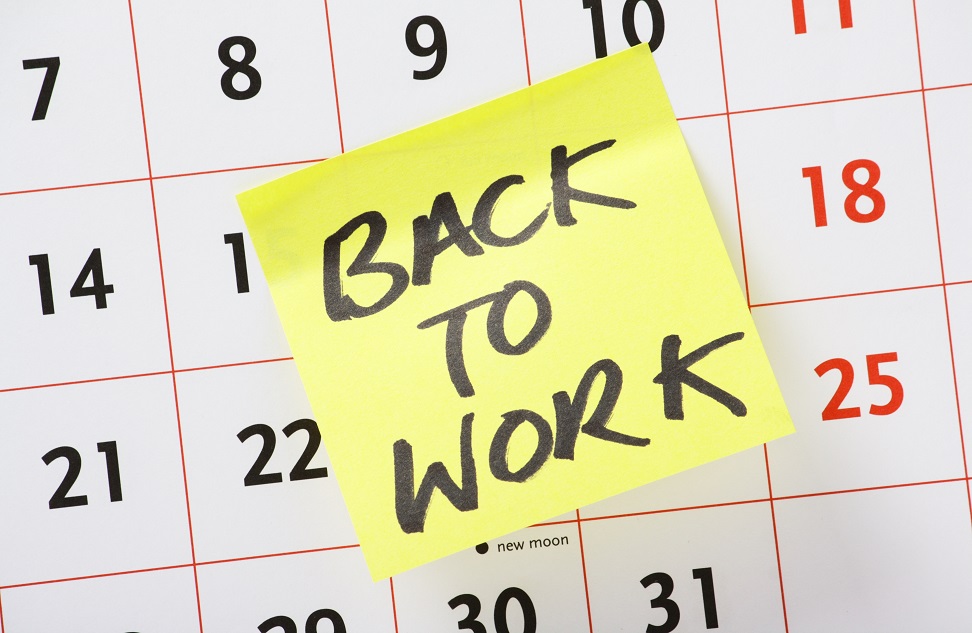Staff may have to return to their offices and workplaces after July 19 after an extended period working from home.
We’ll be asking if you can force staff to come back to the workplace and what risks you need to be aware of.
Why are staff expected to return to work?
As part of his announcement yesterday (July 5), Boris Johnson said that the ‘work from home wherever possible’ advice would be lifted. From July 19, it’ll be up to employer whether they ask their staff to come back into the workplace.
Aside from that, the PM also outlined from this date that:
- Masks will no longer be a legal requirement
- Social distancing rules will end
- All businesses that are closed will reopen
- Covid-19 certificates will not be a legal requirement
- Travellers who are double jabbed won’t have to quarantine after returning from amber-list countries
An announcement may follow that those who are double jabbed won’t have to self-isolate if one of their colleagues contracts the virus. Self-isolation is expected to be replaced by a regular testing regime.
What’s more, the government has no plans to introduce a legal right to work from home. There are also no plans to introduce labour laws that will entitle a worker to refuse to go into work if they feel unsafe when masks and social distancing are no longer company policy.
The reception of this news has been mixed. As well as social distancing and mask-wearing being scrapped, there are concerns about not being able to fund lateral flow tests once the government stops paying for them after July. The rapid growth in the Delta variant and concerns about the Lambda variant have some arguing that the easing is premature. Data from the Future Strategy Club reveals that 57 per cent of British workers don’t want to return to their previous 9-5 job after the pandemic.
Though some sort of transition back to the workplace is happening. Figures from the Office of National Statistics (ONS) show that the number of businesses that have been operating on a homeworking or a furlough basis and are moving to a hybrid model has grown by 11 per cent. Around the same proportion are expected to do so in the next fortnight.
What can I do as an employer?
In short, if your employees were contracted to work in-house before, you can ask them to come back. Tony Prevost, HR director EMEA at Skillsoft, said: “If an employee’s contract of employment states their workplace then the company is within its rights to ask employees to return to the office.”
He adds that as there is a final communication expected next week, employers should start to look at the practicalities before making any final recommendations, as this message may change.
“On the assumption that the government changes its tone removing the recommendation to work at home, companies are within their rights to ask for a return to the office.”
However, he said, there are two things companies should consider before implementing such an edict: 1) the government has mooted around changes in law regarding rights to work from home; and 2) if delivered incorrectly, employers may receive a raft of flexible working requests which will be hard to defend against since people have been working from home for a long period of time.
“Thus, companies are advised to look at phased returns to the office, respecting the environment that people have become used to.”
However, you might not want to force staff back to work if you risk losing your talent.
“If top talent decides to leave their place of employment when lockdown restrictions lift, firms will face a talent crisis and run the risk of losing their competitive edge because of it,” said Justin Small, CEO of Future Strategy Club. “This means it is now essential that the UK workforce becomes more enticing for its employees.”
He argues that short-term solutions and office perks are simply not enough to encourage the UK workforce back to the office, with the benefit of these perks often being short-lived. What’s important is listening to your employees and their concerns and allow staff to work remotely if they are uncomfortable returning to work and ensure that they feel safe. “By implementing safety measures, the return to the office can be easily managed,” said Ben Thompson, CEO of Employment Hero.
If your employees don’t feel comfortable returning with protections in place, you could keep them in place for as long as you’d like. In a survey by JD Cooling, more than two thirds of employees (68 per cent) are worried about contracting Covid-19 when they return to work. Almost half said that their biggest concern was catching the virus through airborne transmission.
With this in mind, it could be of some relief to your employees to know that you’re keeping measures like mask wearing, social distancing, Perspex screens and increased ventilation in place.
“It is important employers listen to their employees and offer ‘Total Employment Care’ where possible. Don’t make assumptions about employee resistance to the vaccine or returning to the office. Share verified information with your employees and be open to their feedback,” said Thompson.
“A full return to the office might not happen in 2021, or ever, and employers should be prepared for this. Invest in the tools that keep both productivity and communication up and don’t overlook an incredibly talented workforce just because of their personal health choices or remote working preferences.”
To manage workplaces, 37 per cent of employers suggest they will be making vaccination mandatory for their employees, according to research from Employment Hero. Read more about this in Can I make my employees get the Covid-19 vaccine?
What could happen to WFH in the longer term?
Some employers have shifted to a remote or hybrid model for the long-term. Though employees have no automatic right to work from home, they do have rights when it comes to flexible working.
Kate Hindmarch of Langleys Solicitors said that employees with at least 26 weeks’ service have the right to ask for flexible working. This can include working from home for some or all of the time. As an employer, you are required to consider requests in a reasonable manner and can only refuse a request for one of the eight business reasons permitted by legislation:
- The burden of additional costs
- A detrimental effect on the ability to meet customer demand
- An inability to reorganise work among other employees
- An inability to recruit additional employees
- A detrimental effect on quality
- A detrimental effect on performance
- Insufficient work at the times when the employee proposes to work
- Planned structural changes
Be extra careful here as you could stumble on a discrimination case. “More women than men seek flexible working arrangements so rejection of a woman’s homeworking request may amount to indirect sex discrimination unless the treatment can be objectively justified,” said Hindmarch.
“A disabled employee may also have some protection in relation to a homeworking request. In particular, the employer’s duty to make reasonable adjustments in relation to a disabled person is likely to be relevant.”
What about other parts of the UK and workplaces that aren’t offices?
“As businesses bring people back into shared environments, employers have a duty of care to ensure the safety of their employees,” said Kathryn Barnes, employment counsel EMEA at Globalization Partners. “Based on government guidelines, there is a great deal of variation in how workplaces are being organised. In retail and hospitality, for example, shops and restaurants on the same street are interpreting safety rules with different styles of service, with some more strict than others.” She said that it underlines the point that circumstances remain extremely challenging, mistakes will be made and employers must take time to implement decisions about returning to work with great care.
It’s also important to make sure that the guidelines implemented are relevant to the country in which your employee is working and not where your business is based. England, Wales, Northern Ireland and Scotland all have differing guidelines.
So, whatever you decide to do from July 19, it’s best to come from an employee-first standpoint.
“Organisations that don’t have effective and ongoing dialogue with their employees are at much greater risk of breaching employment rights, opening themselves up to claims. Indeed, The Law Society recently predicted an ‘avalanche’ of post-Covid claims, and called for the time allowed to lodge a claim to be doubled from three to six months,” said Barnes.





